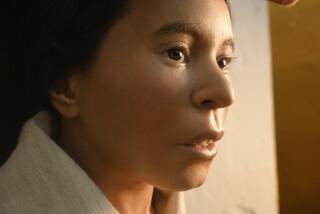Inca child sacrifices were drugged weeks before death, study finds
Three children used as ritual sacrifices by the Inca civilization centuries ago were given a significant amount of drugs and alcohol for months before their deaths, according to an analysis of the frozen bodies found near the top of an Andean peak in South America.
The findings, published in Proceedings of the National Academy of Sciences, give researchers a remarkably detailed two-year timeline of a child sacrifice’s final months.
The children were discovered in 1999 less than 30 yards from the snow-capped summit of the 22,110-foot-high Llullaillaco volcano in northern Argentina. Each body was entombed separately, in chambers facing different directions (north, east, and southwest). Together, according to the study led by Andrew Wilson of the University of Bradford in England, they represent “arguably the best naturally preserved assemblage of mummies found anywhere in the world.”
Two of the children, a girl and a boy, were about ages 4 to 5. The third, a 13-year-old girl known as the Llullaillaco Maiden, had been treated differently from the other two. She had long hair in many tiny, tight braids, wore a feather headdress and held a wad of coca still clenched in her teeth. (In comparison, the little girl’s hair was much less cared for, and the little boy’s hair was infested with nits.)
Using hair collected on site as well as hair taken directly from the scalp, an international team of researchers began to piece together the weeks and months leading up to the sacrifice. Hair can act as a chemical timeline of sorts: One centimeter represents about a month’s growth, and it can hold a record of what was happening in the body at the time. The 13-year-old’s braids were so long that the researchers were able to look two years back before her death.
They analyzed carbon and nitrogen isotopes to determine if the quality of their food had improved, indicating a rise in status. They examined changes in sulfur and oxygen isotopes to find out if there were any changes in area or altitude that hinted of ritual journeys.
The scientists found that the 13-year-old’s food had improved about a year before her death, a sign that her status had risen. They also found in the hair signs of alcohol and cocaine, found in the coca leaf. She had been given far higher doses of alcohol and coca than the boy and girl had received, though the amount had varied over time. Cocaine use peaked around six months before death -- nearly three times higher than earlier levels -- and alcohol use peaked in the 13-year-old’s final weeks, the authors found.
The mounting evidence raises a question of “whether, in the final weeks, the consistently higher levels of [cocaine] and alcohol found in the Maiden’s hair, compared with the younger children, may suggest a greater need to sedate her,” the authors wrote.
Unlike at other Inca sacrifice sites, the children hadn’t suffered any blows to the head; they must have died in some other way. The 13-year-old was sitting cross-legged with her hands loosely resting in her lap, surrounded by an arrangement of plates and drinking vessels. Given that the ceremonial dishes were undisturbed, it’s possible she was placed there either while sedated or shortly after her death. It’s unclear what killed the children, though hypothermia is a possibility, the authors said.
Child sacrifices were a ritual part of Inca culture. The Inca Empire was the largest in the Americas before the Europeans arrived, and taking children from subject populations was thought to be a way of cementing their ties to regions they conquered, the authors wrote. Though culturally treated as an honor, putting the children’s bodies in such highly visible spots as Llullaillaco served a political purpose, according to the authors: to keep the subject populations too afraid to cause the regime any trouble.
“Although the carefully choreographed sacrifice of ‘donated’ children brought direct socioeconomic benefits to tributary groups who supplied them,” they continued, “the ritual would unavoidably — whatever its internal ideological and religious rationale, and however complicit the parents or the wider group — have created a climate of fear.”






